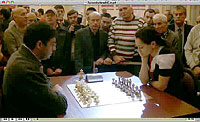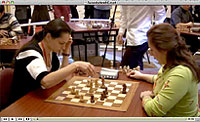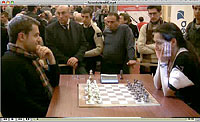Play Chess to Keep Brain Fit: New Study by Radiological Society of North America
Chess blog for latest chess news and chess trivia (c) Alexandra Kosteniuk, 2012
Hi everyone,
The old ‘use it or lose it’ adage may well hold some credence according to a new study presented at the annual meeting of the Radiological Society of North America (RSNA).
Researchers from Rush University Medical Center and Illinois Institute of Technology in Chicago, who studied the effect of late-life cognitive activity on the brain’s white matter, have concluded that reading newspapers, writing letters and playing games like chess, do contribute to a healthier brain.
The researchers used a magnetic resonance imaging (MRI) method known as diffusion tensor imaging (DTI) to generate data on diffusion anisotropy, a measure of how water molecules move through the brain. In white matter, diffusion anisotropy exploits the fact that water moves more easily in a direction parallel to the brain's axons, and less easily perpendicular to the axons, because it is impeded by structures such as axonal membranes and myelin.
"This difference in the diffusion rates along different directions increases diffusion anisotropy values," explained researcher Dr Konstantinos Arfanakis, "Diffusion anisotropy is higher when more diffusion is happening in one direction compared to others."
The anisotropy values in white matter drop, however, with aging, injury and disease.
"In healthy white matter tissue, water can't move as much in directions perpendicular to the nerve fibres," Dr. Arfanakis said. "But if, for example, you have lower neuronal density or less myelin, then the water has more freedom to move perpendicular to the fibres, so you would have reduced diffusion anisotropy. Lower diffusion anisotropy values are consistent with aging."
The study included 152 elderly participants, mean age 81 years, from the Rush Memory and Aging Project, a large-scale study looking at risk factors for Alzheimer's disease. Participants were without dementia or mild cognitive impairment, based on a detailed clinical evaluation. Researchers asked the participants to rate on a scale of 1 to 5 the frequency with which they participated in a list of mentally engaging activities during the last year. Among the activities were reading newspapers and magazines, writing letters and playing cards and board games.
Participants underwent brain MRI using a 1.5-T scanner within one year of clinical evaluation. The researchers collected anatomical and DTI data and used it to generate diffusion anisotropy maps.
Data analysis revealed significant associations between the frequency of cognitive activity in later life and higher diffusion anisotropy values in the brain.
"Several areas throughout the brain, including regions quite important to cognition, showed higher microstructural integrity with more frequent cognitive activity in late life," said Dr. Arfanakis. "Keeping the brain occupied late in life has positive outcomes."
According to Dr. Arfanakis, diffusion anisotropy drops gradually beginning at around age 30. "Higher diffusion anisotropy in elderly patients who engage in frequent cognitive activity suggests that these people have brain properties similar to those of younger individuals," he said.
The researchers will continue to follow the study participants.
"We’ve shown an association between late-life cognitive activity and structural integrity, but we haven't shown that one causes the other," Dr. Arfanakis said. "We want to follow the same patients over time to demonstrate a causal link."
From Alexandra Kosteniuk's
Also see her personal blog at
Don't miss Chess Queen™
Labels: chess and science, chess research, radiological society of north america




































0 Comments:
Post a Comment
Note: Only a member of this blog may post a comment.
Subscribe to Post Comments [Atom]
<< Home